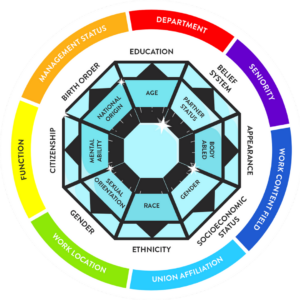The concept of birth order has long been a hot subject for many different “-ological” researchers: psychological, sociological, and anthropological. Because of this, the impact of birth order on personality traits, career choices, and relationships has been rather well documented. However, an underexplored facet of this influence is its impact on management style.
While teaching a workshop in Intercultural Leadership, we showed the Diversity Diamond shown below. We had the participants reflect on which of these attributes they considered the most and the least. Birth Order was consistently communicated as one of the least considered attributes. However, one manager spoke up. He was Asian and talked about growing up the youngest in a large Asian family. He was always told that as the youngest, he should listen to his parents and then his older siblings, in order. It was only after considering the Diversity Diamond that he realized the impact this had on his role as a manager – especially with direct reports who were older than him. His upbringing made it particularly challenging for him to provide critical feedback. But now that he realized why, it gave him the opportunity to grow as a manager.

With globalization and intercultural exchanges becoming widespread and common in the workplace, it’s important for us to investigate how birth order, when combined with cultural background, affects our leadership and management style in different work contexts.
Western Perspectives on Birth Order and Management Style
Note: The below are generalizations that can be inaccurate when weighing such important individual factors as biology, security, emotional safety, and access to education.
Individualism and Firstborn Leadership
In Western societies, driven by individual values, firstborn children are often groomed for leadership from a young age1. They are more likely to be detail-oriented, responsible, and organized. These traits translate into a managerial style that is often authoritative and structured. Firstborns in Western cultures may gravitate towards centralized decision-making and clearly defined roles within the team.
Middle Children as Diplomats
Middle-borns, on the other hand, can develop skills of negotiation and compromise, as they navigate the waters between older and younger siblings2. In management roles, they may excel in conflict resolution and tend to adopt a more democratic leadership style, seeking input from all team members before making decisions.
Last-borns and Innovation
The youngest children in Western families are often the most free-spirited, growing up in a less controlled environment as parents become less stringent with rules3. This can translate to a management style that is flexible, creative, and open to new ideas.
Eastern Perspectives on Birth Order and Management Style
Note: The below are generalizations that can be inaccurate when weighing such important individual factors as biology, security, emotional safety, and access to education.
Collectivism and Filial Piety
Eastern cultures, like those in China, Japan, and Korea, often emphasize collectivist values and filial piety. This context can modify how birth order impacts management style. In such cultures, firstborns bear a significant responsibility to uphold family honor and tradition4. This might make them more risk-averse and conservative in their management approach. At the same time, the younger a child is, the more likely they have been raised to listen to their older siblings and older generations. This can make speaking up feel like a challenge if a manager is supervising people who are older than them.
Interdependence and Role Hierarchy
The importance of interdependence and role hierarchy in some Eastern cultures often leads to a more autocratic management style regardless of birth order5. Decisions may be made by the leader, with limited input from subordinates, which mirrors traditional family structures. Some Eastern companies have had to work hard to overcome this tendency – especially when it comes to calling out safety hazards.
Gender Roles and Management
Gender roles can also play a significant part in Eastern cultures (although this certainly isn’t exclusive to the East), where the eldest male child might be predisposed to a more authoritative management style, while female children, regardless of birth order, might adopt a more participative style due to their socialization into more nurturing roles6. As well, the language that women use to communicate can often be less direct about the action (as in “this is what you need to do”) and leave more space for discussion (as in “it might be better for you to do this”) than men.
A Global Confluence: Synergizing Styles
As the business world becomes increasingly global, there is a growing need to understand how birth order and culture intersect to influence management styles. The key to successful international business may lie in recognizing these nuances and adapting management practices accordingly.
Keeping these influences in mind, companies and organizations can work to help their managers and C Suite widen and grow their style of leadership. Aspects of one specific type of leadership might be better in different situations. So providing your leadership staff with training and room to practice different approaches (even ones outside their comfort zone) can help them lead more effectively in a wider variety of circumstances, depending on the cultures of the individuals they are managing.
—
1: Sulloway, Frank J. “Born to Rebel: Birth Order, Family Dynamics, and Creative Lives.” Pantheon, 1996.
2: Salmon, Catherine, and Katrin Schumann. “The Secret Power of Middle Children: How Middleborns Can Harness Their Unexpected and Remarkable Abilities.” Penguin, 2011.
3: Adler, Alfred. “The Individual Psychology of Alfred Adler.” Harper Perennial, 1956.
4: Ho, David Yau-fai. “Filial Piety, Authoritarian Moralism, and Cognitive Conservatism in Chinese Societies.” Genetic, Social, and General Psychology Monographs, 1994.
5: Hofstede, Geert. “Culture’s Consequences: Comparing Values, Behaviors, Institutions and Organizations Across Nations.” Sage publications, 2001.
6: Eagly, Alice H., and Blair T. Johnson. “Gender and Leadership Style: A Meta-Analysis.” Psychological Bulletin, 1990.
Contact us for more information about our Prismatic Leadership Program and our other professional development courses.




